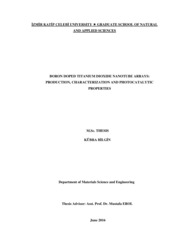Boron doped titanium dioxide nanotube arrays: production, characterization and photocatalytic properties
-
Eser Sahibi
Bilgin, Kübra
- Tez Danışmanı Mustafa EROL
-
Tür
Yüksek Lisans
- Yayın Tarihi 2016
-
Yayıncı
İzmir Katip Çelebi Üniversitesi Fen Bilimleri Enstitüsü
- Tek Biçim Adres Http://hdl.handle.net/11469/649
-
Konu Başlıkları
Mineralizasyon
Mineralization
Fotokatalitik parçalanma
Photocatalytic degradation
Photocatalytic degradation and complete mineralization of toxic organic compounds in water, soil, and air in the presence of semiconductor materials have received much attention over the last decades. Electronic structure of semiconductors is characterized by a filled valence band and an empty conduction band. When the semiconductor is irradiated with light of sufficient energy corresponding to or exceeding its band gap, an electron is promoted into the conduction band, leaving a hole in the valence band. The electrons and holes are good reductants and powerful oxidants, respectively, and they can initiate redox reactions on the semiconductor surface. Titanium dioxide (TiO2) as a semiconductor is considered the most promising photocatalyst due to its high efficiency, chemical stability and non-toxicity. Due to the fact that in this study, titanium dioxide nanotube arrays fabricated by potentiostatic anodization of titanium that offers a large internal surface area. TiO2 nanotube arrays have been found to possess outstanding charge transport and carrier lifetime properties enabling a variety of advanced applications, including their usage as sensors, dye sensitized solar cells, hydrogen generators, photocatalysts, and super capacitors. However, the use of TiO2 is restricted by its wide band gap (3.2-3.6 eV), which requires ultraviolet irradiation for photocatalytic activation (λ <387 nm). In addition, UV light include accounts for only about 5 % of solar energy; visible light, 45 %. The shift of the optical response of TiO2 from UV to the visible spectral range will have a profound positive effect on the efficient use of solar energy in photocatalytic reactions. Thus, much effort has been directed toward the development of visible light-active photocatalysts. With this manner aim of With this manner aim of With this manner aim of With this manner aim of With this manner aim of With this manner aim of With this manner aim of With this manner aim of With this manner aim of With this manner aim of With this manner aim of With this manner aim of With this manner aim of With this manner aim of study study is to reduce the band gap energy of TiO2 nanotubes through boron (B) doping. Both pure and doped TiO2 nanotube arrays (TNTAs) were fabricated on pure titanium substrates and stable nanotube production was performed by anodization process. Electrochemical anodization process was followed by a heat treatment which led the transformation of amorphous structure in to crystalline anatase phase. Samples were characterized by X-ray diffraction (XRD), diffuse reflectance absorption spectroscopy (DRS), atomic force microscopy (AFM) and scanning electron microscopy/energy-dispersive X-ray spectroscopy (SEM/EDS). Finally, photocatalytic efficiencies were tested under UV light and photocatalytical degradation and kinetics were evaluated by UV-Visible spectrophotometer.
-
Koleksiyonlar
ENSTİTÜLER
FEN BİLİMLERİ ENSTİTÜSÜ

 Tam Metin
Tam Metin

